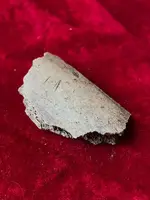Goethe said:
What's the hardest thing for you to see? It's what's in front of your face !
A centuries-old axiom in the fine arts: "Everybody
looks. What you have to do is, learn to
see." Artifacts are stories in stone. They can be read, assuming lithic literacy on the part of the one studying them.
In this case, starting with the distal side (first picture), notice that those broad flakes could not have been struck from a piece that small. For one thing, percussion flakes start narrow and spread out (fan-shapes). These are already wide, indicating that they were struck from further back from where the edges of it are now. For another thing, even if some way had been found around this, a work piece that small would "give" with the force of the removing blows unless it were immobilized in a vice, so the flakes would have petered out (been unable to "run" as far as the flake scars on that show that they did).
So what the top side tells you is that the knapper was using a Levallois strategy, striking flakes off from the periphery toward the center (without reaching it) while this was still part of a much larger block, then lifting it off with an impact from the right-angled edge. (Interestingly, although Levallois flakes typically have big bulbs of percussion, this one doesn't, which would point to the use of a punch rather than direct percussion with a hammerstone). (Levallois technology never stopped being useful, so it never went out of use).
In the second picture (ventral side), on the ragged edge you see heavy stepping that runs directly along the latitudinal axis. This is the same flake behavior you see in bipolar percussion, where a pebble is struck while held on an anvil stone (remember the part about small pieces "giving" with the force of a blow, not being heavy enough to resist them ?). In this case, the mechanics are those of a wedge that was struck from the opposite edge being used on something hard (bone rather than wood). And sure enough, the edge opposite the stepped side shows battering/crushing from repeated blows with a hammerstone.

